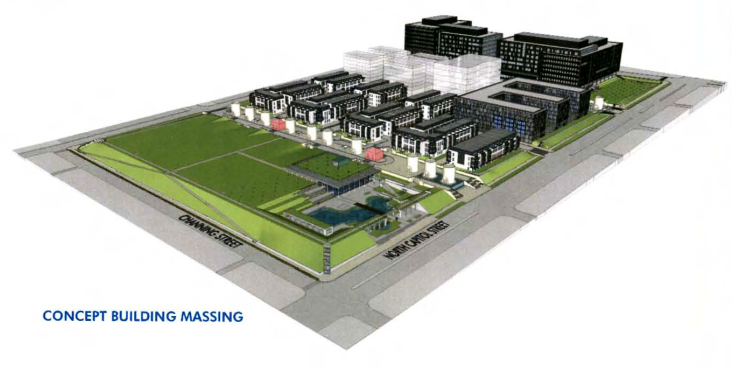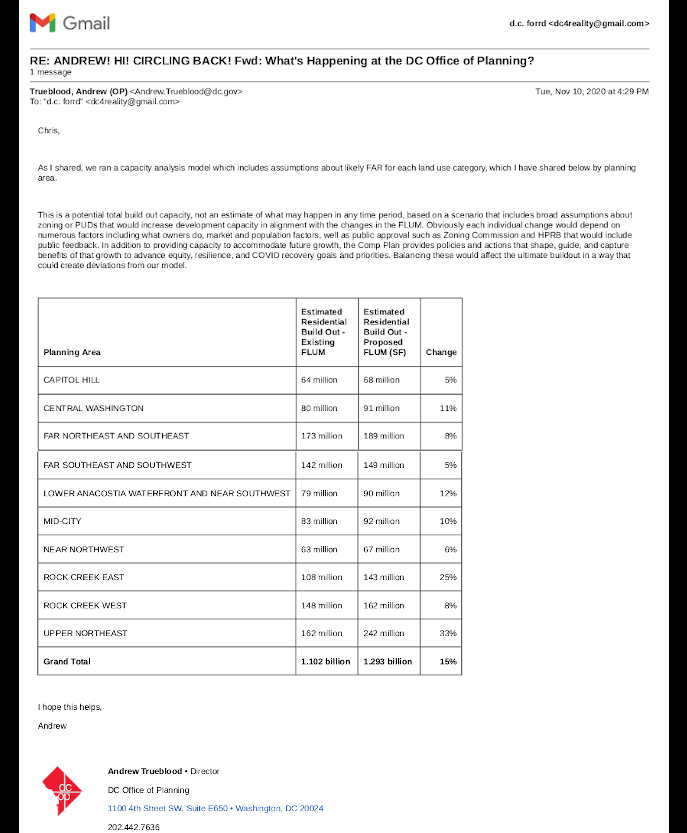There are maps within the Comp Plan, the most important being the Future Land Use Map (FLUM).
The Future Land Use Map (FLUM) determines how DC will develop and grow as we move into the future and allows all residents and city planners to anticipate and prepare for development, no surprises!
The DC Office of Planning under the direction of the DC Mayor is now suggesting changes to the Comprehensive Plan, 1500-redlined pages of proposed amendments to the existing Plan policies and maps. They have delivered these proposed changes to the DC City Council to consider passing into law.
The Mayor put up a website to show the public (to a degree) the massive tome of amendments to the Plan. By the way, if you don’t speak or read English, you have been left completely out of the conversation.
On the Mayor’s Comp Plan website, there is a nifty maps page that was recently uploaded that uses a slider to let you see the proposed areas of the city where the Office of Planning wants to change future development, going up with bigger and denser buildings.
Sliding over the whole city and you see an array of properties that the Mayor seeks to upzone, aka upFLUM. What you don’t see are the numbers in square feet of how much density the mayor wants to allow to be developable as a “matter of right” (MOR).
In fact, no where on the Mayor’s Comprehensive Plan website will you find any facts relaying to the public that the proposed FLUM map changes equate to upzoning close to 200 million square feet of land and air rights.
As a friend suggests, the map changes show city officials essentially printing money for the landowners of these lucky properties being upFLUMed.
How did we get the numbers? A Socratic conversation with the director of the Office of Planning, Director Andrew Trueblood, and his staff by email.
The result of this conversation was a matrix showing the reality of the proposed changes to the Comprehensive Plan FLUM map, or almost 200 million square feet of proposed upzoning around the city.
This 200 million square feet of new habitable space and construction represents about what would be 100 “matter of right” McMillan Park projects.
Do you think this substantial change to the city’s built environment came with any impact assessments as required by the law? If you answered No, you’d be correct.
Why should we expect the Mayor’s Office of Planning actually do any “planning”? In fact the DC Council Chairman thinks planning is a popularity contest!
Read how the Office of Planning’s proposed changes to the Comp Plan is going to exacerbate displacement of Black folks in DC, click here.
]]>Transit Opinion by: Iris McCrea, Ward 7 Resident and Fort Dupont Civic Association Member
. . .
The position of the Fort Dupont Civic Association is against the extension of the Streetcar beyond the Langston Golf Course at Oklahoma Avenue, NE to East Capitol Street and Benning Road NE. However, we do support transit-oriented development along Benning Road and through sub-neighborhoods from Oklahoma Avenue to Southern Avenue which is even beyond the proposed end of the streetcar route.
. . .
[T]he Fort Dupont Civic Association strongly recommends the use of the Circulator Buses starting at Oklahoma Avenue instead of streetcars.
See Full Statement Here.
]]>
Save McMillan Park #FACTS
Context: McMillan Park is 25+ acres of open land at North Capitol Street and Michigan Avenue, NW, still largely as it was when the federal government opened it in 1905 to control typhoid and other water-borne diseases in the city. Designed by Frederick Law Olmsted, Jr., it was a public, integrated park until WWII, when it was closed for security purposes. The national and local historic landmark, with panoramic views of downtown Washington, was bought by the city in 1987 for $9.3M. Take a look at the history of the federally protected historic landmark at McMillan Park.

The Mayor’s McMillan Plan and Behavior:
The proposed plan is to privatize and demolish McMillan Park as we know it in order to build two+ million square feet of residential, commercial and medical space. This plan has in part been approved by the DC Zoning Commission, the Mayor’s Agent for Historic Preservation and a premature DCRA demolition permit has been issued. These decisions are being appealed, with a temporary stay now in effect from the DC Court of Appeals.
Reasons to Halt Demolition & Save McMillan:
- Because the closest Metro stop is over a mile away, the project will generate 20,000 new vehicle trips/day at N. Capitol/Michigan Ave. and there’s been no study of impacts to emergency responders and on this emergency route from center city;
- Health effects will worsen for an area of the city with some of the highest asthma rates, especially in our children;
- The major land, water and air impacts from the massive demolition and construction have only been superficially examined;
- The District requirement for an environmental impact statement/assessment has been ignored;
- Cell 14, the most north-east sand filtration water cell, is being used now by DC Water to prevent nearby flooding when ever it rains;
- The number of truly affordable units for families, about 25, is embarrassingly low for a project that will have some of the most expensive residential units in the city;
- Residents and businesses will be displaced by the inevitable rise in property values, stimulated by the panoramic views;
- The DC Auditor questioned the ethics in a lack of competition in picking the developer;
- The DC Government is paying millions for lawyers, architects and others, including to a Baltimore pr firm to “neutralize public opposition;”
- The new library requested by the community is absent;
- See more details of the corruption around McMillan Park here.
sign the MCMILLAN PARK petition
CLICK HERE
]]>On September 11, 2019, the COG passed a joint resolution that sets into motion the coordination of housing preservation and production targets across the DMV. The goal: 320,000 new or preserved housing units by 2030, and of these 2/3 of the units should be considered “affordable.” Chair of the COG, DC City Councilmember, Robert White, emphasized that these units should be built to include 3+ bedroom units, aka family-sized units.
Find the COG documentation and resolution below:
* https://www.mwcog.org/
============================
RESOLUTION R27-2019
============================
Major points:
- 320K Housing Units Added 2020-2030 (an additional 75,000 units beyond units already forcast)
- 75% of all new housing should be located in activity centers and around high activity transit (see definitions above)
- 75% of all new housing should be “affordable” to lower- and moderate-income housing (see definitions above).
- To share these goals to all constituents and set targets for each jurisdictions.
- To work with non profit private and philathnropic entities to advance these goals
ROBERT WHITE — AYES UNANIMOUS RESOLUTION MWCOG R27-2019 PASSES SEP 11 2019
============================
DEFINITIONS
============================
In reviewing the resolution and information from the COG about the Housing Production targets please understand the following definitions as they can be interpreted:
- Accessibility — Locating housing close to transportation, transit centers, or “activity centers.” This term has almost nothing to do with universal accessibility a principle of the disability advocacy community.
- Affordable Housing — Housing that costs $2,500/m or less. There is no mention of bedroom sizes or housing costs as a percentage of one’s income. It is strictly the government setting levels of profit making, shifting market forces and volatility from the private sector onto the public.
============================
NEWS REPORTS
============================
Some news reports that came out after:
- WAPO — https://www.washingtonpost.
com/local/dc-regions-elected- officials-urge-their- governments-to-commit-to- affordable-housing-targets/ 2019/09/11/aabcc0e2-d40d-11e9- 9343-40db57cf6abd_story.html
- WTOP — https://wtop.com/local/2019/
09/housing-crisis-dc-area- needs-320000-new-homes-by- 2030-group-says/
- CURBED DC — https://dc.curbed.com/2019/9/
11/20861307/dc-area- development-housing- population-growth-jobs
- WBJ — https://www.bizjournals.com/
washington/news/2019/09/11/d- c-area-leaders-to-set-broad- housing-construction.html
- GGW (opinion) — https://ggwash.org/view/73843/
the-region-sets-new-housing- goals-now-can-it-deliver
============================
OMISSIONS IN THE DISCUSSION
============================
The following are basic planning concepts that wasn’t discussed at all or just briefly by COG before passing the resolution:
- Expiring Affordability — What is the duration of affordable covenants that may run with the land? Shouldn’t we be ensuring that any new or preserved affordable housing exist in perpetuity. What’s the point of expiring affordable housing covenants?
- Public / Universal Housing — The COG made no mention of the importance of public housing and public land while setting these housing targets. Public housing is a permanent safety net to prevent homelessness.
- Analysis of $2500/m — How realistic is it to say “affordable” housing set at $2,500 a month. Doesn’t this just push the status quo?
============================
SOME QUOTES FROM THE COG MEETING
============================
* CHRISTIAN DORSEY, ARLINGTON, COG — “Ready and willing to do our part” “I love three simplistic targets” “This is a big setp for our region” “Our region has failed to effectively deal with housing” “Its complicated” “Roads are full of traffic” “Net effect people are harmed” “Targets are based on thoughtful analysis” “Provide accountability” “Concept of regionalism should not be understated” “lets get it done, im excited”
* DERRICK DAVIS, PG COUNTY, COG — “we explored, what the heck is ami” “no better place to be than the dmv” quotes victor hoskins … as a great thinker. “messaging is absolutely important, crucial to drive home, to give politicos the right message to communicate with our folks”
* JOHN FOUST, FAIRFAX — “economic development critical” “Fairfax board has committed to 5,000 units over 15 years”
* NANCY NAVARRO, MOCO — asks about the “defintion of high impact areas” when referencing jbg report; emphasizes “social justice and racial equity”
* JUSTIN WILSON, ALEX — “addressing concerns about impacts such as overcrowding schools”
* BEV PERRY, DC — “more work needs to be done”
* KATE STEWART, TKPK — “Board Retreat was helpful” quotes Matthew Desmond “Its hard to argue that housing is not an fundamental human need” … “we’ve been echoing that sentiment” “this is an historic event today” “wants to partner with Mont County”
* RUTH ANDERSON, PRINCE WILLIAM, — “Cast vote in favor” “this will help us forge our comprehensive plan”
* SENATOR GEORGE BARKER, VA, “we gotta keep stepping things up” “things already happening that are pushing us in the right direction” “fairfax is doing a tremendous job in preservng affordable housing”
* BRIDGET NEWTON, ROCKVILLE — “i think this is wonderful what we are doing with housing” “something mr jackson said, taking over current garden style neighborhoods and that we need to build hi-rises — its a problem. its a quality of life issue, displacement of current families. there’s something to be said about having a balcony, to play outide, etc.” “we don’t need 2 types — hi rise or single family” “we need a mix of housing and therefore we lived in communities with all kinds of careers and picture, and we must look at the whole picture” “climate of fear — when people hear about more housing they immediate fear the impacts to roads and schools”
* TODD TURNER, PG — “impacts that come along with the housing” “what the pressure brings to things like infrastructure” “we have to be very careful about that”
* SHARON BULOVA, FAIRFAX — abt to introduce resolution “region forward compact in 2010” “we’ve had more success in the goals than we’ve realized” ** “our air is better” “we set targets to clean up our air, and we’ve done that.” “amazon — needs affordable housing” “we need to make sure weh have housing and quality of life for the industry we want to attract and retain in our region” “we want to create affordable housing for the folks we want to work here and live here”
DC Feedback put out our press release with an update on the July calendar here.
and . . . RUN FOR ANC!
]]>TIFs allow the diversion of taxes that would otherwise be generated by these new projects away from the city’s general budget for social needs (schools, parks, affordability, services, etc.), and instead these taxes are used to pay back private bankers whom authorized the TIF credit and municipal loan.
TIFs act as blank checks from the public to fund and externalize private development costs and is considered a form of corporate welfare.
- Here’s the city’s webpage showing data list of TIF districts in DC.
- Here’s the law governing TIFs as found in the DC Code.
- Here’s the city’s Office of Chief Financial Officer 2016 TIF Analysis
* note: all monies noted here are based on annual repayment amounts, not the total TIF amounts
Governments often use TIF resources to prepare land for development or redevelopment. In addition, governments may use TIF revenues to underwrite certain public structures, such as parking garages. If permissible under state statute, the construction of municipal facilities can be financed using TIF revenues. An Elected Official’s Guide to TAX INCREMENT FINANCING by Nicholas Greifer & The Government Finance Officers Association, July 2007.
The most recent District of Columbia TIF is for Union Market developers.
- The TIF will tax existing and new residents living and working in the Union Market area in Wards 5 & 6 to pay for the $85 million dollar TIF. D.C. Council to consider one of city’s largest TIFs ever to support Union Market area
- The City Council is poised to support the Union Market TIF while simultaneously making it harder to access emergency shelter in DC.
WARD 5 TIF
- Here’s the legislative docket for the 2015 Edgewood Developer TIF. D.C. steps in to subsidize MRP’s big dig in Edgewood
THE SOUTHWEST WATERFRONT aka WHARF TIF
- Lobbyist Firm, Carmen Group, Touts the $145+ million WHARF gift
- Here’s Moody’s take on the gift from District taxpayers to Monty Hoffman’s Wharf project.
The Living Social TIF Gift
- It started in 2012 . . . D.C. Council approves LivingSocial tax breaks
- Then there was an update in 2013 showing broken promises . . . LivingSocial has yet to reach hiring and other goals to claim D.C. tax breaks
- Then in 2017, RIP LivingSocial: The fast rise and slow demise of a daily deals company
TIFs as political hot potatoes, a DC neighborhood-level discussion in Bloomingdale in 2010.
Many of the District’s special deals have been very costly. In 2002, Gallery Place, a mixed-use transit-oriented development, received about $80 million in subsidies. To sell the TIF bonds for just this one project, DC had to pledge that incremental sales tax revenue from a much larger area would be made available if necessary. In 2006, another development in a quickly gentrifying neighborhood, the DC-USA mall project anchored by a Target store, received a $42 million TIF package. The District justified the deal in part by claiming it would enhance sales tax revenue in the surrounding neighborhood (DC has a problem with sales tax “leakage” to Maryland and Virginia), but DC has no method of tracking sales tax by location to determine if that worked. Good Jobs First, “Tracking Subsidies, Promoting Accountability in Economic Development,” Accountable USA – District of Columbia webpage.
ANALYSIS: Before [Baltimore] City Hall loved TIFs, it shunned them as bad policy
Tax Increment Financing: A comparison between Washington, D.C. and Chicago, by Jasson Perez, University of Illinois Chicago, 2015.
]]>Over the past several years, DC planning and zoning officials have been reviewing and changing DC’s real estate development rules, a process referred to as the Zoning Regulations Rewrite (ZRR).
The Office of Planning went hard during the #ZRR to amend the zoning code so that the area known as Downtown DC is tripled in size, and where parking requirements are all-together eliminated.
Downtown DC has some of the tallest buildings with most density, driving significant traffic, killing any remaining parking, even in garages, and abusing daily the city’s aging infrastructure, including the recent troublesome time for Metro, a transit system routinely catching on fire.
Back in 2001, WMATA conducted a Metro transit capacity study which had predicted the future, which is now:
Expanding the capacity of the existing Metro system to accommodate a doubling of ridership, which will just maintain its vital market share in the region during the next 25 years, is a prudent and cogent investment. The existing system cost $9.4 billion to construct over a period of thirty years; the $4.5 billion investment in core capacity improvements represents half of that original cost and 20% of the price–more than $22 billion–that would be required to build it today. This investment is in the context of the $246 billion annual economy of the Washington Metropolitan area. The return on investment is compelling: an enhanced and expanded Metro system fully capable of meeting market demand, fostering economic vitality and an enhanced quality of life, meeting the mobility needs of this vibrant region as it continues to grow and providing requisite transit services during times of emergency.

When do the Corporations kick in their fair share?
Using the Zoning Regulations Rewrite process and tapping connections in DC’s planning offices, “Smart Growth” associated agents, Cheryl Cort and David Alpert, have vociferously called for a zoning amendments wishlist serving DC’s real estate investment community, i.e. the loosening of standards governing parking in DC.
Less parking requirements, they say means less cars on the streets and more people on public transit. Perhaps this why Metro has reached capacity in many parts of the system. Yet despite business being good, WMATA’s Metro system is bleeding money.
Part of the reason for increased transit costs is liability. In recent years Metro has demonstrated a keen ability to roll the razor edge of danger for riders and residents who have witnessed high-profile Metro incidents and accidents as part of the larger DC municipal systems collapse.
It is clear, the Metro system is aging and maxing out, leading to burn out and death.
Questions:
- How many more people need to get hurt on Metro, or even die before the City gets serious about regional urban planning?
- Shouldn’t District planning officials be seeking no-strings attached funding from the corporate world, especially those businesses “downtown” who benefit significantly from workers getting to their jobs through DC’s municipal systems? That is, what’s the 1%’s share of our collective transit burden?
- Is it because the smart growth community is funded by developer-interests they won’t advocate that developers be required to contribute to infrastructure and transit upgrade costs serving their new luxury hotel, condo, and office projects?
#ZRR
Chapter: 10-A25 of the DC Municipal Regulations was to guide the ZRR process, but the DC Zoning Commission did not evaluate the efficacy of OP’s zoning review.
The Zoning Regulations Rewrite is scheduled to be implemented this September.
Some residents whose concerns like the tripling of “downtown”, inter-alia, were dismissed by OP and ignored during the zoning review process are organizing to challenge this unacceptably poor planning here in the Nation’s Capitol in the 21st Century.
]]>
